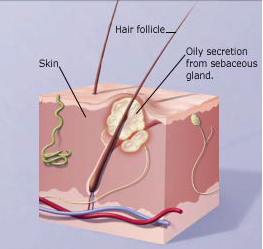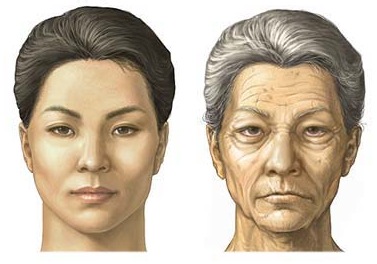When Do you Notice the First Sign of Aging Skin


Interesting How Skin Changes Through Out The Life
As you all know that your skin changes throughout your life so it will be much easier if you understand how skin changes year after year. Most people outgrow acne by the age of 20. By 30 you may see tiny crow`s feet around your eyes which may be your first wrinkles. You also start losing the cells that produce the pigment melanin which leads to a paler complexion and becomes less protective towards sun`s ultraviolet rays. Melanin loss proceeds at the rate of 6 to 8 percent a decade.
At about the age of 40 the fat in the innermost layer of your skin starts to shrink. In the middle layer or dermis the collagen that forms the skin`s fibrous supporting structure gradually decreases, as do the elastin fibers that make your skin flexible. Cell production in the epidermis or outer layer of skin slows. Your skin becomes thinner less supple and more prone to wrinkles.
In your fifties wrinkles becomes deeper and cheeks may sag. Although blood vessels in the skin become sparser on sun damaged faces near the surface blood vessels may make a pattern of red lines called telangiectasia. Glands in the dermis secrete less oil leading to drier skin.
“Nature gives you the face you have it at age 20; at age 50, you get the face you deserve it.” Fashion designer Coco Chanel
In your sixties and seventies your skin becomes more parched, thinner, paler and more wrinkled.
Wrinkles are the most obvious sign of aging generally appear earlier in women than men because men`s skin is thicker. Black or dark skin protected by higher concentrations of melanin which makes their skin stay smooth longer than fair skin.
But wrinkling too is partly under your control. Along with the sun, smoking is a major cause of wrinkles. The chemicals in tobacco constrict blood vessels and thus promote wrinkles by reducing blood flow to the skin. Squinting through the haze hastens the formation of crow`s feet.
Bags and rings appear under the eyes because this area has the thinnest skin in the body. As the skin loses resilience, fluid collects under it, making it bulge and sag. Veins near the surface show through as dark circles. Although a tendency to develop these conditions is hereditary, fatigue and eye irritation exacerbate them. Raising the head of your bed may reduce puffiness by letting fluid drain away. Do not rub your eyes; you may stretch the fragile skin beneath them. And get plenty of sleep. Some researchers believe that body tissues replenish themselves during sleep.
Soothing as a long hot bath may feel, soaking dries aging skin. A lukewarm bath of 15 minutes or less is better. And think twice about bath oil because it can make your tub very slippery. Use half cup of salt in the bath instead. Taking a brief shower is less drying than bathing in plain water. In winter when your skin is exposed to harsh and dry heat, dermatologists suggest limiting showers to three to four times a week. In warm and humid climates, no restriction is necessary.
If your skin is dry choose mild nondrying body soap. Deodorant soap, which works by killing the germs that cause perspiration to smell bad, is some-times harsh on sensitive skin. After your bath or shower, pat and don`t rub yourself, dry and use a moisturizing lotion right away to lock in the water your skin has absorbed.








